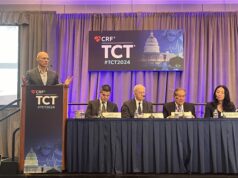 AstraZeneca has today announced that the Medicines and Healthcare products Regulatory Agency (MHRA) has granted a licence extension for dapagliflozin (Forxiga) in Great Britain for the treatment of symptomatic chronic heart failure (HF) in patients with HF and a left ventricular ejection fraction (LVEF) >40%, including HF with mildly reduced ejection fraction (HFmrEF) and preserved ejection fraction (HFpEF).
AstraZeneca has today announced that the Medicines and Healthcare products Regulatory Agency (MHRA) has granted a licence extension for dapagliflozin (Forxiga) in Great Britain for the treatment of symptomatic chronic heart failure (HF) in patients with HF and a left ventricular ejection fraction (LVEF) >40%, including HF with mildly reduced ejection fraction (HFmrEF) and preserved ejection fraction (HFpEF).
The decision means that dapagliflozin is now approved for patients with symptomatic chronic HF across the full spectrum of left ventricular ejection fraction (LVEF), including HF with reduced, mildly reduced, and preserved ejection fraction (HFrEF, HFmrEF, HFpEF), AstraZeneca said in a press release.
John McMurray (Institute of Cardiovascular and Medical Sciences, University of Glasgow, Glasgow, UK), said of the development: “Today’s approval from the MHRA is a significant moment for patients living with heart failure in Great Britain, particularly for those with a preserved ejection fraction, who until now, have had few treatment options. Dapagliflozin has been clinically shown to reduce hospitalisations and cardiovascular deaths in heart failure and as a clinician, I am pleased to see this decision that will bring us closer to addressing the full spectrum of heart failure and reducing the significant disease burden in Great Britain.”
The decision from the MHRA was based on results from the DELIVER Phase III trial, which showed that dapagliflozin met its primary endpoint in reducing the composite outcome of cardiovascular (CV) death or worsening HF by 18%—16.4% in the dapagliflozin group and 19.5% in the placebo group over a median follow-up of 2.3 years (hazard ratio [HR]=0.82; 95% confidence interval [CI] 0.73‒0.92, p<0.001; absolute risk reduction [ARR] 3.1%). The treatment effect was consistent across the LVEF range, without evidence of attenuation of effect by LVEF.
Additionally, the prespecified, patient level, pooled analysis of the DELIVER and DAPA-HF Phase III trials demonstrated that dapagliflozin reduced the risk of CV death by 14% (HR=0.86; 95% CI 0.76‒0.97]; p=0.01, ARR 1.5%) over the median follow-up of 22 months, death from any cause by 10% (HR=0.90 [95% CI 0.82-0.99]; p=0.03, ARR 1.5%), total (first and repeat) hospitalisation for HF by 29% (rate ratio [RR]=0.71; 95% CI 0.65‒0.78; p<0.001; ARR 6%) and the composite of death from CV causes, myocardial infarction, or stroke by 10% (HR=0.90; 95% CI 0.81-1; p=0.045, ARR 1.3%) in patients with HF irrespective of LVEF.
Ed Piper, medical and scientific affairs director, AstraZeneca UK, said: “We are delighted that the MHRA has authorised dapagliflozin for use in heart failure with preserved ejection fraction. We continue to work with NICE and the SMC to ensure that patients living with heart failure can access dapagliflozin as quickly as possible. Today’s milestone demonstrates AstraZeneca’s commitment to deliver effective medicines that improve outcomes for patients across the full spectrum of heart failure.”
In the DELIVER Phase III trial, data was only collected on serious adverse events (AEs) that led to discontinuation of dapagliflozin or placebo and other select AEs, as a result of the extensive safety data on dapagliflozin and established safety profile. Overall, serious AEs, including death, were reported in 43.5% of patients (n=1361) in the dapagliflozin group and in 45.5% of patients (n=1423) in the placebo group. AEs that led to discontinuation of dapagliflozin or placebo were reported in 5.8% of patients (n=182) in the dapagliflozin group and in 5.8% of patients (n=181) in the placebo group.













